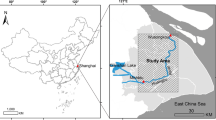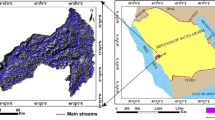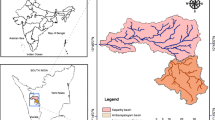Abstract
Hydrologic data derived from digital elevation models (DEM) has been regarded as an effective method in the spatial analysis of geographical information systems (GIS). However, both DEM resolution and terrain complexity has impacts on the accuracy of hydrologie derivatives. In this study, a multi-resolution and multi-relief comparative approach was used as a major methodology to investigate the accuracy of hydrologie data derived from DEMs. The experiment reveals that DEM terrain representation error affects the accuracy of DEM hydrological derivatives (drainage networks and watershed etc.). Coarser DEM resolutions can usually cause worse results. However, uncertain result commonly exists in this calculation. The derivative errors can be found closely related with DEM vertical resolution and terrain roughness. DEM vertical resolution can be found closely related with the accuracy of DEM hydrological derivatives, especially in the smooth plain area. If the mean slope is less than 4 degrees, the derived hydrologie data are usually unreliable. This result may be helpful in estimating the accuracy of the hydrologie derivatives and determining the DEM resolution that is appropriate to the accuracy requirement of a particular user. By applying a threshold value to subset the cells of a higher accumulation flow, a stream network of a specific network density can be extracted. Some very important geomorphologie characteristics, e.g., shallow and deep gullies, can be separately extracted by means of adjusting the threshold value. However, such a flow accumulationbased processing method can not correctly derive those streams that pass through the working area because it is hard to accumulate enough flow direction values to express the stream channels at the stream’s entrance area. Consequently, errors will definitely occur at the stream’s entrance area. In addition, erroneous derivatives can also be found in deriving some particular rivers, e.g., perched (hanging up) rivers, anastomosing rivers and braided rivers. Therefore, more work should be done to develop and perfect the algorithms.
Similar content being viewed by others
References
Band L E. Topographic partition of watersheds with digital elevation models.Water Resources Research, 1986,22(1): 15–24.
Fairfield J, Leymarie P. Drainage networks from grid digital elevation models.Water Resources Research, 1991,27 (5): 709–717.
Jenson S K, Domingue J O. Extracting topographic structure from digital elevation data for geographic information system analysis.Photogrammetric Engineering and Remote Sensing, 1988,54 (11): 1593–1600.
Martz L W, Garbrecht J. Numerical definition of drainage network and subcatchment areas from digital elevation models.Computers and Geosciences, 1992,18 (6): 343–349.
O’Callaghan J F, Mark D M. The extraction of drainage networks from digital elevation data.Computer Vision, Graphics and Image Processing, 1984.28 (3): 323–344.
Drayton R S, Wilde B, Harris H K. Geographical information system approach to distribution modeling.Hydrological Processes, 1991,6 (3): 361–368.
Jepson S K. Applications of hydrologic information automatically extracted from digital elevation models.Hydrological Processes, 1991,6 (1): 31–44.
Moore I D, Garrison R B, Laden A R. Digital terrain modelling A review of hydrological, geomorphologie and biological applications.Hydrological Processes, 1991,6 (1): 3–30.
Quinn P, Bevel K, Chevalier Pet al. The prediction of hillslope flow paths for distributed hydrological modelling using digital terrain models.Hydrological Processes, 1991,6 (1): 59–79
Walsh S J, Lightfoot D R, Butler D R. Recognition and assessment of error in geographic information systems.Photogrammetric Engineering and Remote Sensing, 1987,53 (10), 1423–1430.
Tarboton D G, Bras R L, Rodriques-Iturbe I. On the extraction of channel networks from digital elevation data.Hydrological Processes, 1991,6 (1): 81–100.
Mark D M, Aronson P B. Scale-dependent fractal dimensions of topographic surfaces: An empirical investigation with applications in geomorphology and computer mapping.Mathematical Geology, 1984,16 (7), 671–683.
Tang Guo’an. A research on the accuracy of digital elevation models. New York: Science Press Beijing New York, 2000. 10.
Tang Guo’an, Josef Strobl, Gong Jianyaet al. Evaluation on the accuracy of digital elevation models.Journal of Geographical Sciences, 2001, 11 (2): 209–216.
Author information
Authors and Affiliations
Rights and permissions
About this article
Cite this article
Guo-an, T., Yang-he, H., Strobl, J. et al. The impact of resolution on the accuracy of hydrologic data derived from DEMs. J. Geogr. Sci. 11, 393–401 (2001). https://doi.org/10.1007/BF02837966
Received:
Accepted:
Issue Date:
DOI: https://doi.org/10.1007/BF02837966




